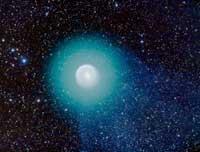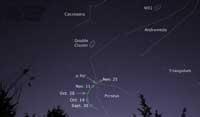Comet that has exceeded the size of the sun

Comets are actually very common. They are bodies that rotate in a certain orbit and, occasionally, when they pass near the Earth, they are visible. In general they are formed by ice and dust, most of them small. They consist of a nucleus of a few kilometers in diameter and a cloud surrounded by small particles of dust and ice. Astronomers have identified several comets, including the comet 17P Holmes that we are dealing with today. Known for over a hundred years, its diameter is about 3.4 kilometers, very common.
If it is so normal, what has made it important? Well,
On October 23, in twenty-four hours, its brightness multiplied by a million times and its size soared. In fact, in early November, astronomers at the Institute of Astronomy in Hawaii claimed that the diameter of 17P Holmes was larger than that of the Sun.
In fact, it is not possible to compare the diameters of comets and stars: That of the Sun is 1,392,000 kilometers, that is, almost 400,000 times the core of the comet that we have in hand. In this case, in addition to the kite core, the cloud around it has been taken into account to calculate its diameter. And the cloud around the comet has increased so much.

It seems that the core of the kite broke that day, and part of the inner ice began to be expelled and expanded. Like many comets, the Holmes comet has a layer of carbon in the form of soot around the core, and when it broke it began to extract the ice from the core. Thus, the cloud around the nucleus grew more and more to exceed the diameter of the Sun, and as the ice reflects the luminosity of the Sun became brighter and brighter.
Therefore, the diameter of the kite has increased, but in exchange for reducing the core, that is, expanding the core components and not increasing the amount of mass. An increase in mass along with diameter would cause an enormous imbalance of gravity in the solar system, as it would affect the planets to a greater attraction than the Sun itself (since it depends on the gravity mass of a body).

Fortunately this did not happen. And that huge size is also a matter of time. As they leave the core, the components of the comet are constantly expanding and expanding and the cloud is growing. However, as they expand, they will become fully dispersed dust and ice particles at any given time, and cannot be said to be part of the comet. Then, only ice cubes left in the core can be considered an integral part of the comet. Astronomers now want to know what diameter the core of comet 17P Holmes has after losing so much ice.
However, the components of the cloud may still be near the core and the comet may still be visible in the sky. In fact, scientists announced in early November that it would take weeks, or months, for the cloud around the core to disperse completely. So look out the window and luck!
Published in 7K.
Buletina
Bidali zure helbide elektronikoa eta jaso asteroko buletina zure sarrera-ontzian











